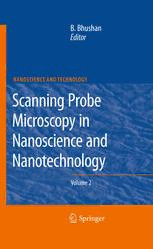Table Of ContentNanoScience and Technology
NanoScience and Technology
SeriesEditors:
P.Avouris B.Bhushan D.Bimberg K.vonKlitzing H.Sakaki R.Wiesendanger
TheseriesNanoScienceandTechnologyisfocusedonthefascinatingnano-world,meso-
scopicphysics,analysiswithatomicresolution,nanoandquantum-effectdevices,nano-
mechanicsandatomic-scaleprocesses.Allthebasicaspectsandtechnology-orientedde-
velopmentsinthisemergingdisciplinearecoveredbycomprehensiveandtimelybooks.
Theseriesconstitutesasurveyoftherelevantspecialtopics,whicharepresentedbylea-
dingexpertsinthefield.Thesebookswillappealtoresearchers,engineers,andadvanced
students.
PleaseviewavailabletitlesinNanoScienceandTechnologyonserieshomepage
http://www.springer.com/series/3705/
Bharat Bhushan
(Editor)
Scanning Probe
Microscopy
in Nanoscience
and Nanotechnology
2
With 453 Figures
123
Editor
ProfessorBharatBhushan
OhioStateUniversity
2
NanoprobeLaboratoryforBio-andNanotechnologyandBiomimetics(NLB )
201,West19thAvenue
Columbus,OH43210-1142,USA
E-mail:[email protected]
SeriesEditors:
ProfessorDr.PhaedonAvouris ProfessorDr.,Dres.h.c.KlausvonKlitzing
IBMResearchDivision Max-Planck-Institut
NanometerScaleScience&Technology fu¨rFestko¨rperforschung
ThomasJ.WatsonResearchCenter Heisenbergstr.1
P.O.Box218 70569Stuttgart,Germany
YorktownHeights,NY10598,USA
ProfessorHiroyukiSakaki
ProfessorDr.BharatBhushan UniversityofTokyo
OhioStateUniversity InstituteofIndustrialScience
NanotribologyLaboratory 4-6-1Komaba,Meguro-ku
forInformationStorage Tokyo153-8505,Japan
andMEMS/NEMS(NLIM)
Suite255,AckermanRoad650 ProfessorDr.RolandWiesendanger
Columbus,Ohio43210,USA Institutfu¨rAngewandtePhysik
Universita¨tHamburg
ProfessorDr.DieterBimberg Jungiusstr.11
TUBerlin,Fakuta¨tMathematik/ 20355Hamburg,Germany
Naturwissenschaften
Institutfu¨rFestko¨rperphyisk
Hardenbergstr.36
10623Berlin,Germany
NanoScienceandTechnology ISSN1434-4904
ISBN978-3-642-10496-1 e-ISBN978-3-642-10497-8
DOI10.1007/978-3-642-10497-8
Springer Heidelberg Dordrecht London New York
©Springer-VerlagBerlinHeidelberg2011
This work is subject to copyright. All rights are reserved, whether the whole or part of the material is
concerned,specificallytherightsoftranslation,reprinting,reuseofillustrations,recitation,broadcasting,
reproductiononmicrofilmorinanyotherway,andstorageindatabanks.Duplicationofthispublicationor
partsthereofispermittedonlyundertheprovisionsoftheGermanCopyrightLawofSeptember9,1965,in
itscurrentversion,andpermissionforusemustalwaysbeobtainedfromSpringer.Violationsareliableto
prosecutionundertheGermanCopyrightLaw.
Theuseofgeneraldescriptivenames,registerednames,trademarks,etc.inthispublicationdoesnotimply,
evenintheabsenceofaspecificstatement,thatsuchnamesareexemptfromtherelevantprotectivelawsand
regulationsandthereforefreeforgeneraluse.
Cover design: eStudio Calamar Steinen
Printed on acid-free paper
Springer is part of Springer Science+Business Media (www.spinger.com)
Foreword
Natureisthebestexampleofasystemfunctioningonthe
nanometer scale, where the involved materials, energy
consumption, and data handling are optimized. Open-
ing the doors to the nanoworld, the emergence of the
scanning tunneling microscope in 1982 and the atomic
force microscope in 1986 led to a shift of paradigm
in the understanding and perception of matter at its
most fundamentallevel.As a consequence,new revolu-
tionary concepts stimulated a number of new technolo-
gies. The current volume of Scanning Probe Methods
in Nanoscience and Nanotechnology shows that these
methodsare still makinga tremendousimpacton many
disciplines that range from fundamental physics and
chemistry through information technology, spintronics, quantum computing, and
molecularelectronics,allthe wayto life sciences. Indeed,morethan6,000AFM-
relatedpaperswerepublishedin2008alone,bringingthetotaltomorethan70,000
since its invention, according to the Web of Science, and the STM has inspired a
totalof20,000papers.Therearealso morethan500patentsrelatedtothe various
formsofscanningprobemicroscopes.Commercializationofthetechnologystarted
attheendofthe 1980s,andapproximately12,000commercialsystemshavebeen
soldsofartocustomersinareasasdiverseasfundamentalresearch,thecarindustry,
andeventhefashionindustry.Therearealsoasignificantnumberofhome-builtsys-
temsinoperation.Some60–80companiesareinvolvedinmanufacturingSPMand
relatedinstruments.Indeed,noteventheskyseemstobethelimitforAFMtechnol-
ogy.TheRosettamissiontocomet67PlaunchedbytheEuropeanSpaceAgencyin
2004includesanAFMinitsMicro-ImagingDustAnalysisSystem(MIDAS)instru-
ment. The goalof this mission, which is expectedto touchdownon 67P in 2014,
istoanalyzeparticlesizedistributionsincometmaterial.NASA’sPhoenixmission
to Mars in 2008 included an AFM for similar studies (collaboration between the
UniversitiesofNeuchaˆtelandBasel,aswellaswithNanosurfGmbH).
Whatdoesthefuturehold?Nanotechnologyisstilldominatedtoacertainextent
by the top-down approach where miniaturization plays a crucial role. However,
thereisaworldwideeffortofmeetingthebottom-upapproachofself-assemblyand
v
vi Foreword
self-organization that has been so successfully implemented in the natural world.
Researchers are trying to unravel nature’s secrets on a nanometer scale to create
a new generation of materials, devices, and systems that will spectacularly out-
perform those we have today in information technology, medicine and biology,
environmentaltechnologies,the energyindustry,andbeyond.As we better under-
standhownatureisdoing“things”onafundamentallevel,achievementslikeclean
chemistryorcleanprocessingwillemergealongwithhowtohandlewasteproblems
and not polluting the environment. New smart materials, hybrid or heterostruc-
tured, as well as carbon nanotubes, a variety of nanowires or graphene could be
the ingredientsfor novelenergy-savingdevices. In order to understand the whole
functionality of a cell, Systems Biology Institutes have been established with the
hope of artificially synthesizing a cell in a bottom-up approach. Nanomedicine,
including noninvasivediagnostics, will be more and more on the agenda, fighting
diseasesonthemolecularlevel,e.g.,newkindsofdrug-deliverysystemsbasedon
peptidesorblockcopolymernanocontainersareinvestigatedaspossiblecarriersto
targetcarcinogeniccells.Biologyisdrivenbychemistry;however,thescaffold,the
gears, the knots and bolts, e.g., in cell membranes, is nanomechanics, a template
thatnaturehasorchestratedduringeonsofevolutionandworthwhiletryingtocopy
andimplementinnovelnanodevices.
However, to keep this worldwide effort alive, the interdisciplinary structure of
nanorequiresa new breedofscientists educatedin allscience disciplineswith no
languagebarriers,readytomakeanimpactonalltheglobalchallengesaheadwhere
nanotechnologycan be applied.1 Scanningprobemicroscopyandrelated methods
willstillplayanimportantroleinmanyoftheseinvestigations,helpingtocapitalize
onthisfundamentalknowledge,beneficialforfuturetechnologiesandtomankind.
Prof.ChristophGerber
(Co-invertorofAFM)
(FormerlyatIBMZurichResearchLaboratory)
NationalCompetenceCenterforResearchinNanoscaleScience(NCCR)
InstituteforPhysics
UniversityofBasel
Switzerland
1Nano-curriculumattheUniversityofBasel,http://www.nccr.nano.org/NCCR/study.
Preface
Theemergenceandproliferationofproximalprobes,inparticulartip-basedmicro-
scopies, have found applications in a large number of fields of scientific and
industrialinterest.Theseallowinvestigationsdowntotheatomicscale.Therecent
focusonnanotechnologyhasmadeprobe-basedmethodsindispensible.Thepresent
editorcoeditedwithProf.H.Fuchs13volumesonappliedscanningprobemethods
(SPM) from 2004to 2009.These volumeshave provideda timely comprehensive
overviewofSPMapplications.
The success of the Springer Series Applied Scanning Probe Methods and the
rapidly expanding activities in scanning probe development and applications in
nanoscienceandnanotechnologyworldwidemakesitanaturalsteptocollectfurther
specific results in the fields of development of scanning probe microscopy tech-
niques, characterization, and industrial applications, particularly in nanoscience,
nanotechnology,andbiomimetics.In2010,theeditorlaunchedaseriesofvolumes
on ScanningProbeMicroscopyin NanoscienceandNanotechnology.Thissecond
volumeprovidesinsightintotherecentworkofleadingspecialistsintheirrespec-
tive fields. The focus in this volume is on the fundamentaldevelopmentsin SPM
techniques.
This volume introduces many technical concepts and improvements of exist-
ing scanning probe techniques and covers a broad and impressive spectrum of
recent SPM development and application in many fields of technology, biology,
andmedicine.Thechaptersaregivenunderthreemajorheadings:ScanningProbe
MicroscopyTechniques,Characterization,andIndustrialApplications.Afterintro-
ducing new developments in scanning probe microscopy, characterization data in
variousapplicationsofscientificandtechnologicalinterestispresented.Next,chap-
ters on various industrial applications are presented. Characterization data and
industrial applications include studies of biological materials, nanostructures, and
nanotubes.
The chapters are written by leading researchersand applicationscientists from
allovertheworldandfromvariousindustriestoprovideabroaderperspective.The
field is progressing so fast that there is a need for a set of volumes every 12–18
monthstocapturethelatestdevelopments.
Wegratefullyacknowledgethesupportofallauthorsrepresentingleadingscien-
tists in academiaand industry forthe highlyvaluable contributionto this volume.
vii
viii Preface
We also cordially thank the series editor Claus Ascheron and his staff member
Adelheid Duhm from Springer for their continued support during the publication
process.
We sincerely hope that readers find this volume to be scientifically stimulating
andrewarding.
Columbus,OH,USA BharatBhushan
September2010
Contents
PartI ScanningProbeMicroscopyTechniques
1 Time-ResolvedTapping-ModeAtomicForceMicroscopy............... 3
AliFatihSariogluandOlavSolgaard
1.1 Introduction............................................................. 3
1.2 Tip–SampleInteractionsinTM-AFM................................. 5
1.2.1 InteractionForcesinTM-AFM.............................. 5
1.2.2 Cantilever Dynamics and Mechanical
BandwidthinTM-AFM...................................... 6
1.3 AFM Probes with Integrated Interferometric
HighBandwidthForceSensors........................................ 8
1.3.1 Model ......................................................... 9
1.3.2 InterferometricGratingSensor............................... 13
1.3.3 SensorMechanicalResponse&TemporalResolution ..... 19
1.3.4 Fabrication.................................................... 21
1.3.5 DetectionSchemes ........................................... 23
1.3.6 CharacterizationandCalibration............................. 26
1.3.7 Time-ResolvedForceMeasurements........................ 27
1.4 ImagingApplications .................................................. 30
1.4.1 NanomechanicalMaterialMapping ......................... 31
1.4.2 Imagingof MolecularStructuresin Self
AssembledMonolayers ...................................... 32
1.4.3 ImagingMicrophaseSeperation
inTriblockCopolymer....................................... 33
1.5 Conclusion.............................................................. 34
References...................................................................... 35
2 SmallAmplitudeAtomicForceSpectroscopy............................. 39
Sissi de Beer, Dirk van den Ende, Daniel Ebeling,
andFriederMugele
2.1 Introduction............................................................. 39
2.2 SmallAmplitudeSpectroscopy........................................ 42
2.2.1 ActuationTechniques ........................................ 43
2.2.2 EffectFrequencyDependentDamping...................... 53
ix
x Contents
2.3 Summary................................................................ 54
References...................................................................... 57
3 CombiningScanningProbeMicroscopyandTransmission
ElectronMicroscopy ......................................................... 59
Alexandra Nafari, Johan Angenete, Krister Svensson,
AnkeSanz-Velasco,andHa˚kanOlin
3.1 Introduction............................................................. 60
3.1.1 WhyCombineSPMandTEM?.............................. 60
3.2 SomeAspectsofTEMInstrumentation............................... 62
3.3 IncorporatinganSTMInsideaTEMInstrument..................... 63
3.3.1 ApplicationsofTEMSTM ................................... 66
3.4 IncorporatinganAFMInsideaTEMInstrument..................... 75
3.4.1 OpticalForceDetectionSystems............................ 76
3.4.2 Non-opticalForceDetectionSystems....................... 77
3.4.3 TEMAFMApplications...................................... 80
3.5 CombinedTEMandSPMSamplePreparation....................... 84
3.5.1 NanowiresandNanoparticles................................ 85
3.5.2 AProperElectricalContactforTEMSPM.................. 87
3.5.3 LamellaSamples.............................................. 90
3.5.4 ElectronBeamIrradiationEffects ........................... 90
3.6 Conclusion.............................................................. 92
References...................................................................... 93
4 Scanning Probe Microscopyand Grazing-Incidence
Small-Angle Scattering as Complementary Tools
fortheInvestigationofPolymerFilmsandSurfaces .....................101
PeterMu¨ller-BuschbaumandVolkerKo¨rstgens
4.1 Introduction.............................................................101
4.2 StatisticalAnalysisofSPMData......................................103
4.3 IntroductiontoGrazing-IncidenceSmall-AngleScattering..........109
4.4 ComparisonofRealandReciprocalSpaceData .....................113
4.5 ComplementaryandInSituExperiments.............................117
4.6 CombinedInSituGISAXSandSPMMeasurements................127
4.7 SummaryandOutlook.................................................128
References......................................................................129
5 Near-FieldMicrowaveMicroscopyforNanoscience
andNanotechnology..........................................................135
Kiejin Lee, Harutyun Melikyan, Arsen Babajanyan,
andBarryFriedman
5.1 PrinciplesofMicrowaveMicroscope .................................135
5.1.1 Introduction...................................................135
5.1.2 Near-fieldInteraction.........................................136
5.1.3 MicrowaveFrequencies......................................138

